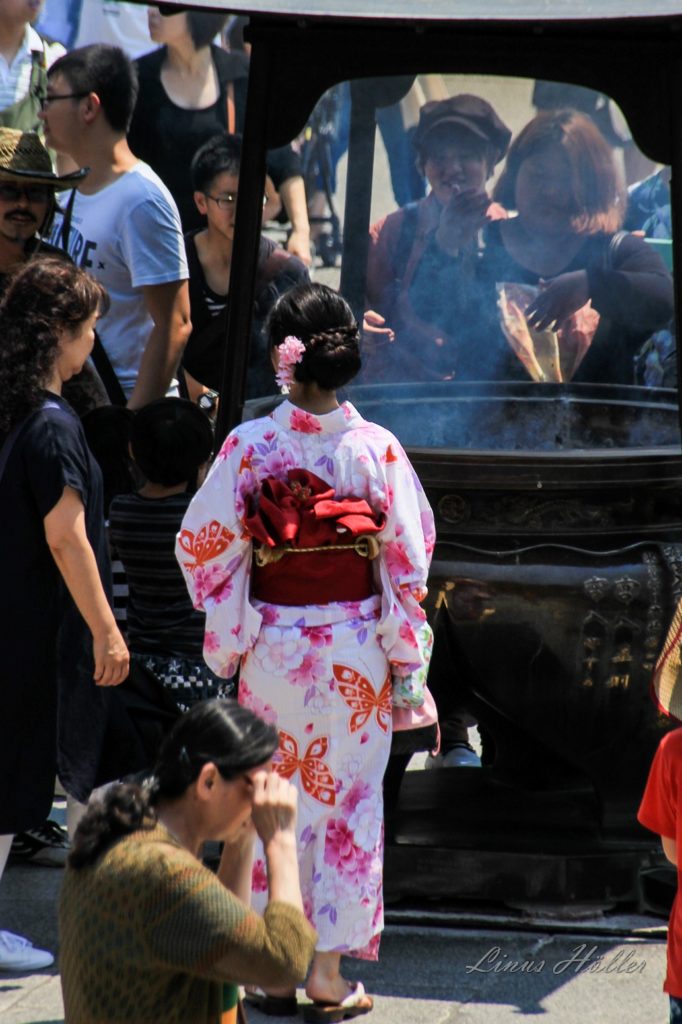Tokyo is hectic. Considering it is the world’s largest city, with a metro area population of close to 40 million, that may not come as too big of a surprise. Tokyo, at least in summer, is also very hot. Temperatures during my stay didn’t drop under 25°C at night, and during the day, they reached up to 36°C while all the time being very humid due to Tokyo’s proximity to the ocean. Despite these factors, which may act as a turn-off for many travelers, there was something about Tokyo that captivated me. To this day, I am unable to specifically put my finger down on what it was. Perhaps it was the very combination of stuffy and hectic that fascinated me. I certainly wouldn’t rule out the possibility of me spending a few years of my life in Japan’s capital.
With its population size, one may assume that Tokyo never sleeps. And though it is a metropolis, and it lights up like one at night, I felt there was a clear distinction between the daytime bustle and the more subdued nighttime activity, and much more so than in cities such as New York.
That isn’t to say that it isn’t worth going outside at night – it certainly is. As in almost any city, there are things to be discovered only at night, and you get a rare glimpse into the lives of the hard-working Japanese outside of office hours.
Let us move from the night into the day, and venture through the city. Tokyo has a pretty modern feel (following the US’ bombing in World War Two, much of the city had to be rebuilt), but at the same time, walking through the city, you mostly pass through residential areas. Big streets with lots of signs and the famous diagonal crosswalks certainly aren’t the norm – but they do exist!
One of the absolute must-sees in Tokyo is also one of the most overrun places of the city, but it is by no means some super-hyper-modern sight. The Sensō-ji temple is a Buddhist temple which was built just shy of 1,400 years ago. Today, it is the most visited spiritual site in the world, receiving over 30 million visitors annually. For comparison, that is over five million people more than live in Australia. The temple, smack-bang in the middle of Tokyo, forms a sharp contrast to the surrounding modern city as a place where tradition and modernity mix – a process that I could observe repeatedly later while journeying through Japan.
No city visit is complete for me without going up one of the highest available buildings and having a view of the city from edge to edge. In Tokyo, though, I was only partly able to do so. Not because there wasn’t a sufficiently tall building – the absolutely gargantuan Tokyo Skytree stands some 634 meters tall – but because Tokyo’s metro area is too vast to be seen completely at once, even from the world’s tallest tower (the Burj Khalifa in Dubai is taller, but it doesn’t officially count as a tower, but rather as a “structure”).
Getting around such a massive city in a foreign country, with a foreign language and a foreign system of writing may seem a daunting task. Let me therefore give you a brief overview of some of the things that I did, that significantly helped me find my way around.
First and foremost, let me say that it is considerably easier to get around Tokyo than you might think. They have a buttload of trains going practically everywhere. However, there are several different operators, and therefore you will have to be conscious of what ticket you have. Signs in the metro system are generally also given in the Latin alphabet, which is useful. Nonetheless, I would highly recommend downloading an offline Tokyo rail navigation app onto your phone (there’s a wide variety available) in order to help you find the best routes. Google maps is also helpful – you can also download maps to be available offline on Google maps (though transit navigation won’t work that way). If you can at all afford it, get yourself a mobile sim whenever travelling! Data can get you out of many difficult situations! Whether you have a SIM card or not, though, definitely download Japanese on google translate to be available offline. Even in Tokyo, many if not most people won’t be able to speak even basic English. A quick translation may come in handy more than once, especially when you’re lost in a Tokyo train station at rush hour.
Finally, one last thing: Inform yourself about what is going on while you’re in the city. Considering the size, it is almost guaranteed that some event is taking place. I had luck while I was in Japan, witnessing a whole bunch of festivals, events, markets, etc. Do your research, and go beyond the big travel guide books & websites, try to “go local” before you even get to Tokyo. Seize any opportunity to immerse yourself into the local way of life!




























